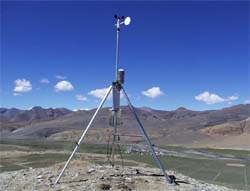
A team of researchers from the CAS Institute of Atmospheric Physics (IAP), the CAS Institute of Tibetan Plateau Research and the China Association for Scientific Expedition started a scientific experiment on the atmosphere over the Mt. Qomolangma (Everest) on May 17. It is a field monitoring part of the Land-Atmosphere Exchange in the Himalayas, a key research project jointly supported by CAS and National Natural Science Foundation of China.
Monitoring carried out by IAP scientists on the Qomolangma environment from 2000 to 2004 showed that there exists a unique local composite system of atmospheric circulation in the region. The strong wind along the Himalayas caused by the system brings atmospheric substance and energy from the upper air down to the ground, playing an important role in the global changes and the climate and environment variations in East Asia. To have an insight into the energy exchange process of the substance brought about by the atmospheric circulation, the researchers have conducted studies through a method combining observation, theoretical analyses, and digital simulation.
Prof. ZOU Han, chief scientist of the project from IAP, says that the research will offer a comprehensive and in-depth understanding of the role played by the Qinghai-Tibetan Plateau in the changes of China's climate and environment. It will greatly upgrade the forecasting level of climate and environment.
Over the next 45 days, the research team will set up a multi-level observation system by ways of a vertical profile detection of wind and temperature with radio- and sonic-radars, ultrasonic atmospheric circulation monitoring towers, seven-pointed atmospheric and solar radiation observations, as well as air and aerosol sample collection. On the basis of the experiments in 2006 and 2007, it is expected that the researchers will develop multi-scale numerical modeling to be used in the Himalayas and other regions for the exploration of the roles of the large high land on the land-atmospheric exchanges of plateaus.





